
This is a list of reptiles found in the state of Virginia, including both native and introduced species with an established population.

This is a list of reptiles found in the state of Virginia, including both native and introduced species with an established population.
| Name | Species / Subspecies | Family | Conservation status | |||
|---|---|---|---|---|---|---|
| IUCN Red List | Federal (ESA) | State (Virginia DWR) | State (NatureServe) | |||
| Loggerhead sea turtle | Caretta caretta | Cheloniidae | | Threatened | State Threatened | Critically Imperiled (S1) |
| Green sea turtle | Chelonia mydas | Cheloniidae | | Threatened | State Threatened | |
| Hawksbill sea turtle | Eretmochelys imbricata | Cheloniidae | | Endangered | State Endangered | |
| Kemp's ridley sea turtle | Lepidochelys kempii | Cheloniidae | | Endangered | State Endangered | Critically Imperiled (S1) |
| Common snapping turtle | Chelydra serpentina | Chelydridae | | Secure (S5) | ||
| Leatherback sea turtle | Dermochelys coriacea | Dermochelyidae | | Endangered | State Endangered | |
| Painted turtle | Chrysemys picta | Emydidae | | Secure (S5) | ||
| Spotted turtle | Clemmys guttata | Emydidae | | Apparently Secure (S4) | ||
| Eastern chicken turtle | Deirochelys reticularia reticularia | Emydidae | State Endangered | Critically Imperiled (S1) | ||
| Wood turtle | Glyptemys insculpta | Emydidae | | State Threatened | Imperiled (S2) | |
| Bog turtle | Glyptemys muhlenbergii | Emydidae | | Endangered (S/A) | State Endangered | Imperiled (S2) |
| Northern map turtle | Graptemys geographica | Emydidae | | Vulnerable (S3) | ||
| Northern diamondback terrapin | Malaclemys terrapin terrapin | Emydidae | | Vulnerable (S3) | ||
| River cooter | Pseudemys concinna | Emydidae | | Apparently Secure (S4) | ||
| Coastal plain cooter | Pseudemys floridana | Emydidae | Vulnerable (S3) | |||
| Northern red-bellied cooter | Pseudemys rubriventris | Emydidae | | Apparently Secure (S4) | ||
| Eastern box turtle | Terrapene carolina carolina | Emydidae | | Apparently Secure (S4) | ||
| Pond slider | Trachemys scripta | Emydidae | | Apparently Secure (S4) | ||
| Striped mud turtle | Kinosternon baurii | Kinosternidae | | Apparently Secure (S4) | ||
| Eastern mud turtle | Kinosternon subrumbrum subrumbrum | Kinosternidae | | Secure (S5) | ||
| Stripe-necked musk turtle | Sternotherus minor peltifer | Kinosternidae | | Imperiled (S2) | ||
| Eastern musk turtle | Sternotherus odoratus | Kinosternidae | | Secure (S5) | ||
| Northern spiny softshell turtle | Apalone spinifera spinifera | Trionychidae | | Imperiled (S2) | ||
| Name | Species / Subspecies | Family | Conservation status | ||
|---|---|---|---|---|---|
| IUCN Red List | State (Virginia DWR) | State (NatureServe) | |||
| Eastern slender glass lizard | Ophisaurus attenuatus longicaudus | Anguidae | | Apparently Secure (S4) | |
| Eastern glass lizard | Ophisaurus ventralis | Anguidae | | State Threatened | Critically Imperiled (S1) |
| Eastern fence lizard | Sceloporus undulatus | Phrynosomatidae | | Secure (S5) | |
| Northern coal skink | Plestiodon anthracinus anthracinus | Scincidae | | Vulnerable (S3) | |
| Common five-lined skink | Plestiodon fasciatus | Scincidae | | Secure (S5) | |
| Southeastern five-lined skink | Plestiodon inexpectatus | Scincidae | | Secure (S5) | |
| Broad-headed skink | Plestiodon laticeps | Scincidae | | Secure (S5) | |
| Little brown skink | Scincella lateralis | Scincidae | | Secure (S5) | |
| Eastern six-lined racerunner | Aspidocelis sexlineatus sexlineatus | Teiidae | | Secure (S5) | |
| Name | Species / Subspecies | Family | Conservation status | |
|---|---|---|---|---|
| IUCN Red List | State (NatureServe) | |||
| Eastern worm snake | Carphophis amoenus amoenus | Colubridae | | Secure (S5) |
| Northern scarlet snake | Cemophora coccinea copei | Colubridae | | Apparently Secure (S4) |
| Northern black racer | Coluber constrictor constrictor | Colubridae | | Secure (S5) |
| Ring-necked snake | Diadophis punctatus | Colubridae | | Secure (S5) |
| Eastern mud snake | Farancia abacura abacura | Colubridae | | Apparently Secure (S4) |
| Common rainbow snake | Farancia erytrogramma erytrogramma | Colubridae | | Vulnerable (S3) |
| Rough earth snake | Haldea striatula | Colubridae | | Apparently Secure (S4) |
| Eastern hognose snake | Heterodon platirhinos | Colubridae | | Secure (S5) |
| Scarlet kingsnake | Lampropeltis elapsoides | Colubridae | | |
| Eastern kingsnake | Lampropeltis getula getula | Colubridae | | Secure (S5) |
| Eastern black kingsnake | Lampropeltis nigra | Colubridae | | Imperiled (S2) |
| Northern mole kingsnake | Lampropeltis rhombomaculata | Colubridae | | Secure (S5) |
| Eastern milk snake | Lampropeltis triangulum triangulum | Colubridae | | Secure (S5) |
| Crayfish snake | Liodytes rigida | Colubridae | | Critically Imperiled (S1) |
| Plain-bellied water snake | Nerodia erythrogaster | Colubridae | | Apparently Secure (S4) |
| Northern water snake | Nerodia sipedon sipedon | Colubridae | | Secure (S5) |
| Brown water snake | Nerodia taxispilota | Colubridae | | Apparently Secure (S4) |
| Northern rough green snake | Opheodrys aestivus aestivus | Colubridae | | Secure (S5) |
| Smooth green snake | Opheodrys vernalis | Colubridae | | Vulnerable (S3) |
| Eastern rat snake | Pantherophis alleghaniensis | Colubridae | | Secure (S5) |
| Corn snake | Pantherophis guttatus | Colubridae | | Apparently Secure (S4) |
| Northern pine snake | Pituophis melanoleucus melanoleucus | Colubridae | | Possibly Extirpated |
| Queen snake | Regina septemvittata | Colubridae | | Secure (S5) |
| DeKay's brown snake | Storeria dekayi | Colubridae | | Secure (S5) |
| Red-bellied snake | Storeria occipitomaculata | Colubridae | | Secure (S5) |
| Southeastern crown snake | Tantilla coronata | Colubridae | | Vulnerable (S3) |
| Eastern ribbonsnake | Thamnophis saurita saurita | Colubridae | | Secure (S5) |
| Eastern garter snake | Thamnophis sirtalis sirtalis | Colubridae | | Secure (S5) |
| Smooth earth snake | Virginia valeriae | Colubridae | | Secure (S5) |
| Eastern copperhead | Agkistrodon contortix | Viperidae | | Secure (S5) |
| Northern cottonmouth | Agkistrodon piscivorus | Viperidae | | Vulnerable (S3) |
| Timber rattlesnake | Crotalus horridus | Viperidae | | Apparently Secure (S4) |

Sorghum or broomcorn is a genus of about 25 species of flowering plants in the grass family (Poaceae). Some of these species are grown as cereals for human consumption, in pastures for animals as fodder, and as bristles for brooms. Sorghum grain is a nutritious food rich in protein, dietary fiber, B vitamins, and minerals.
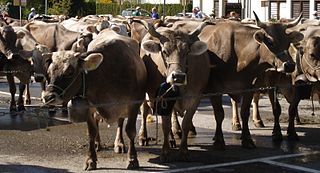
An introduced species, alien species, exotic species, adventive species, immigrant species, foreign species, non-indigenous species, or non-native species is a species living outside its native distributional range, but which has arrived there by human activity, directly or indirectly, and either deliberately or accidentally. Non-native species can have various effects on the local ecosystem. Introduced species that become established and spread beyond the place of introduction are considered naturalized. The process of human-caused introduction is distinguished from biological colonization, in which species spread to new areas through "natural" (non-human) means such as storms and rafting. The Latin expression neobiota captures the characteristic that these species are new biota to their environment in terms of established biological network relationships. Neobiota can further be divided into neozoa and neophyta (plants).

Bidens tripartita is a common and widespread species of flowering plant in the sunflower family, Asteraceae, commonly known as three-lobe beggarticks, three-part beggarticks, leafy-bracted beggarticks or trifid bur-marigold. It is native to much of Eurasia, North Africa, and North America, with naturalized populations in Australia and on some Pacific Islands.
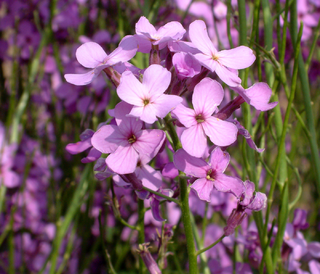
Hesperis matronalis is an herbaceous flowering plant species in the family Brassicaceae. It has numerous common names, including dame's rocket, damask-violet, dame's-violet, dames-wort, dame's gilliflower, night-scented gilliflower, queen's gilliflower, rogue's gilliflower, summer lilac, sweet rocket, mother-of-the-evening, Good & Plenties, and winter gilliflower.

A wildflower is a flower that grows in the wild, meaning it was not intentionally seeded or planted. The term implies that the plant is neither a hybrid nor a selected cultivar that is any different from the native plant, even if it is growing where it would not naturally be found. The term can refer to the whole plant, even when not in bloom, and not just the flower.
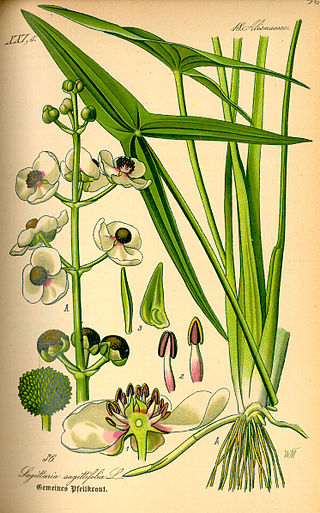
Sagittaria is a genus of about 30 species of aquatic plants whose members go by a variety of common names, including arrowhead, duck potato, swamp potato, tule potato, and wapato. Most are native to South, Central, and North America, but there are also some from Europe, Africa, and Asia.
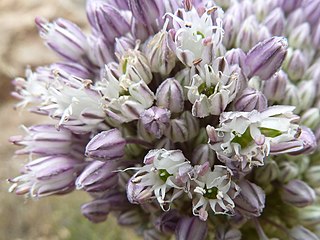
Allium ampeloprasum is a member of the onion genus Allium. The wild plant is commonly known as wild leek or broadleaf wild leek. Its native range is southern Europe to southwestern Asia and North Africa, but it is cultivated in many other places and has become naturalized in many countries.
Naturalisation is the ecological phenomenon through which a species, taxon, or population of exotic origin integrates into a given ecosystem, becoming capable of reproducing and growing in it, and proceeds to disseminate spontaneously. In some instances, the presence of a species in a given ecosystem is so ancient that it cannot be presupposed whether it is native or introduced.

Quercus acutissima, the sawtooth oak, is an Asian species of oak native to China, Tibet, Korea, Japan, Indochina and the Himalayas. It is widely planted in many lands and has become naturalized in parts of North America.
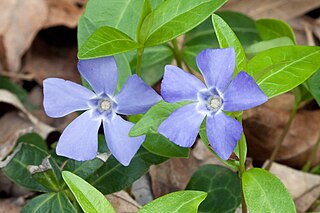
Vinca minor is a species of flowering plant in the dogbane family, native to central and southern Europe, from Portugal and France north to the Netherlands and the Baltic States, east to the Caucasus, and also southwestern Asia in Turkey. Other vernacular names used in cultivation include small periwinkle, common periwinkle, and sometimes in the United States, myrtle or creeping myrtle.
The National Register of Champion Trees is a list of the largest tree specimens found in the United States as reported to American Forests by the public. A tree on this list is called a National Champion Tree.

The pond slider is a species of common, medium-sized, semiaquatic turtle. Three subspecies are described, the most recognizable of which is the red-eared slider, which is popular in the pet trade and has been introduced to other parts of the world by people releasing it to the wild. Hatchling and juvenile pond sliders have a green upper shell (carapace), yellow bottom shell (plastron), and green and yellow stripes and markings on their skin. These patterns and colors in the skin and shell fade with age until the carapace is a muted olive green to brown and the plastron is a dull yellow or darker. Some sliders become almost black with few visible markings. The carapace is oval with a bit of rounding and a central crest with knobs, but these features soften and fade with age, adults being smoother and flatter. For determining an adult slider's sex, males typically have much longer front claws than adult females, while females usually have shorter, more slender tails than males. Their lifespans range from 20 to 50 years.

Rhododendron catawbiense, with common names Catawba rosebay, Catawba rhododendron, mountain rosebay, purple ivy, purple laurel, purple rhododendron, red laurel, rosebay, rosebay laurel, is a species of Rhododendron native to the eastern United States, growing mainly in the southern Appalachian Mountains from West Virginia south to northern Alabama.

Ligustrum japonicum, known as wax-leaf privet or Japanese privet is a species of Ligustrum (privet) native to central and southern Japan and Korea. It is widely cultivated in other regions, and is naturalized in California and in the southeastern United States from Texas to Virginia.

Carduus crispus, the curly plumeless thistle or welted thistle, is a biennial herb in the daisy family Asteraceae. C. crispus is native to multiple different countries all over Europe and Asia, but it is also naturalized in North America. These plants have specific environmental conditions such as the type of soil and the amount of sunlight that must be met before they can grow. There is a breakdown of the species Carduus crispus that tells us the origin and the meaning of each part of the species' name. The leaves, flowers and fruit of this species are described, as well as, the medicinal and wildlife uses.
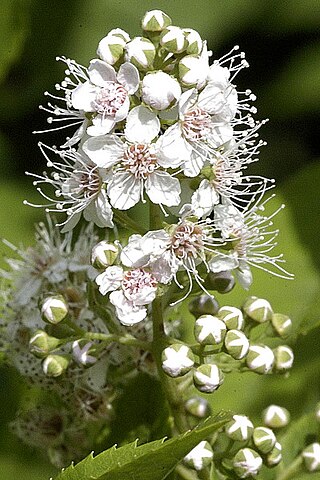
Spiraea alba, commonly known as meadowsweet, white meadowsweet, narrowleaf meadowsweet, pale bridewort, or pipestem, is native to the wet soils of the Allegheny Mountains and other portions of eastern North America, but is currently endangered in the state of Missouri. It is naturalized in other parts of the world.

Bothriochloa ischaemum is a species of perennial grass in the family Poaceae, found throughout much of the world. It is commonly known as yellow bluestem. Two varieties are recognized, of which Bothriochloa ischaemum var. ischaemum is native to Europe, Asia, and Africa and naturalized elsewhere, and var. songarica is native to Asia and naturalized elsewhere. Var. songarica is an invasive weed in Texas, where it is known as "King Ranch bluestem"; it has displaced native grasses in large areas of central and south Texas.
The Alabama Champion Tree Program is a listing of the largest known specimens of particular tree species, native or introduced, in the U.S. state of Alabama. It was established in 1970 by the Alabama Forestry Commission. The program was modeled on the National Register of Big Trees, started by the American Forests organization in 1940. The goal of Alabama's program is to record, heighten awareness of, and preserve the largest tree specimens in the state. It uses the same formula for recording tree specimens that was developed by American Forests. Former champions are removed from the list as new, larger, champions are identified and recorded. Although introduced species that have naturalized are generally eligible for the program, those species that the Alabama Invasive Plant Council considers to be invasive were removed from the listing in 2011 and are no longer eligible. With the addition of 20 new specimens in 2011, the program had a total of 159 Champion Trees listed.